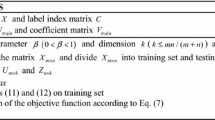Abstract
Non-negative matrix factorization (NMF) is a useful technique to learn a parts-based representation by decomposing the original data matrix into a basis set and coefficients with non-negative constraints. However, as an unsupervised method, the original NMF cannot utilize the discriminative class information. In this paper, we propose a semi-supervised class-driven NMF method to associate a class label with each basis vector by introducing an inhomogeneous representation cost constraint. This constraint forces the learned basis vectors to represent better for their own classes but worse for the others. Therefore, data samples in the same class will have similar representations, and consequently the discriminability in new representations could be boosted. Some experiments carried out on several standard databases validate the effectiveness of our method in comparison with the state-of-the-art approaches.
Similar content being viewed by others
References
Duda R O, Hart P E, Stork D G. Pattern Classification (2nd edition). New York: John Wiley, 2001.
Lin Q L, Sheng B, Shen Y, Xie Z F, Chen Z H, Ma L Z. Fast image correspondence with global structure projection. Journal of Computer Science and Technology, 2012, 27(6): 1281-1288.
Ping Y, Tian Y J, Zhou Y J, Yang Y X. Convex decomposition based cluster labeling method for support vector clustering. Journal of Computer Science and Technology, 2012, 27(2): 428-442.
Lee D D, Seung H S. Learning the parts of objects by non-negative matrix factorization. Nature, 1999, 401(6755): 788-791.
Palmer S E. Hierarchical structure in perceptual representation. Cognitive Psychology, 1977, 9(4): 441-474.
Wachsmuth E, Oram M W, Perrett D I. Recognition of objects and their component parts: Responses of single units in the temporal cortex of the macaque. Cerebral Cortex, 1994, 4(5): 509-522.
Li S Z, Hou X W, Zhang H J, Cheng Q S. Learning spatially localized, parts-based representation. In CVPR, December 2001, Volume 1, pp.207-212.
Xu W, Liu X, Gong Y. Document clustering based on non-negative matrix factorization. In Proc. the 26th ACM SIGIR, July 28-August 1, 2003, pp.267-273.
Xu W, Gong Y. Document clustering by concept factorization. In Proc. the 27th ACM SIGIR, July 2004, pp.202-209.
Cai D, He X, Han J, Huang T S. Graph regularized non-negative matrix factorization for data representation. IEEE Transactions on Pattern Analysis and Machine Intelligence, 2011, 33(8): 1548-1560.
Belkin M, Niyogi P, Sindhwani V. Manifold regularization: A geometric framework for learning from labeled and unlabeled examples. Journal of Machine Learning Research, 2006, 7: 2399-2434.
Basu S, Banerjee A, Mooney R. Semi-supervised clustering by seeding. In Proc. the 19th Int. Conf. Machine Learning, July 2002, pp.19-26.
Liu H F, Wu Z H, Li X L, Cai D, Huang T S. Constrained non-negative matrix factorization for image representation. IEEE Transactions on Pattern Analysis and Machine Intelligence, 2012, 34(7): 1299-1311.
Yang J, Wang J, Huang T. Learning the sparse representation for classification. In Proc. ICME, July 2011.
Lee D D, Seung H S. Algorithms for non-negative matrix factorization. Advances in Neural Information Processing Systems, 2000, 13: 556-562.
Dempster A P, Laird N M, Rubin D B. Maximum likelihood from incomplete data via the EM algorithm. Journal of the Royal Statistical Society: Series B (Methodological), 1977, 39(1): 1-38.
Li F F, Fergus R, Perona P. Learning generative visual models from few training examples: An incremental Bayesian approach tested on 101 object categories. Computer Vision and Image Understanding, 2007, 106(1): 59-70.
Loász L, Plummer M. Matching Theory. American Mathematical Society, 2009.
Author information
Authors and Affiliations
Corresponding author
Additional information
This work was supported in part by the National Basic Research 973 Program of China under Grant No. 2012CB316400, the National Natural Science Foundation of China under Grant Nos. 61025013, 61172129, 61210006, the Fundamental Research Funds for the Central Universities of China under Grant No. 2012JBZ012, and the Program for Changjiang Scholars and Innovative Research Team in University of China under Grant No. IRT201206.
Electronic supplementary material
Below is the link to the electronic supplementary material.
Rights and permissions
About this article
Cite this article
Xiao, YH., Zhu, ZF., Zhao, Y. et al. Class-Driven Non-Negative Matrix Factorization for Image Representation. J. Comput. Sci. Technol. 28, 751–761 (2013). https://doi.org/10.1007/s11390-013-1374-9
Received:
Revised:
Published:
Issue Date:
DOI: https://doi.org/10.1007/s11390-013-1374-9




